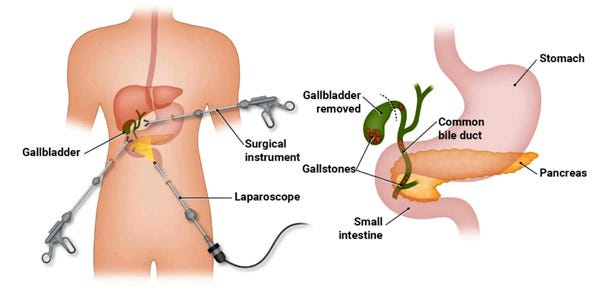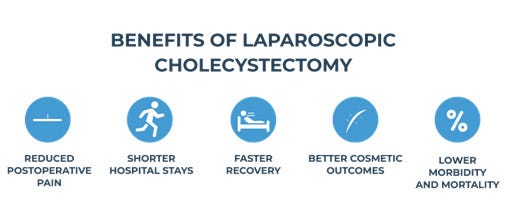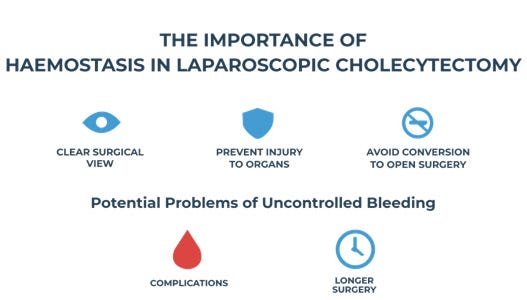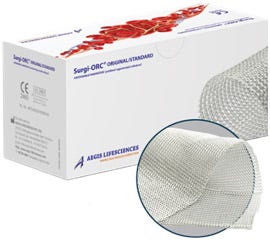Optimizing Haemostasis in Laparoscopic Cholecystectomy with Haemostatic Surgical Dressings
Cholecystectomy, or gallbladder removal surgery, is commonly performed to treat complications from recurrent gallstones. These stones can cause upper abdominal pain, nausea, vomiting, and digestive disturbances. Among the surgical approaches available, laparoscopic cholecystectomy (LC) has emerged as the gold standard for treating gallbladder diseases such as symptomatic cholelithiasis and chronic cholecystitis [1].

Fig.1: Laparoscopic Cholecystectomy [1]
Since its introduction by French surgeon Philippe Mouret in 1987, LC has become one of the most widely performed minimally invasive procedures globally [2]. Its popularity is attributed to several patient benefits, including reduced postoperative pain, lower morbidity and mortality, shorter hospital stays, faster recovery and better cosmetic outcomes.

The Importance of Haemostasis in Laparoscopic Gallbladder Surgery
Despite its minimally invasive nature, LC poses unique technical challenges — especially in managing intraoperative bleeding within a confined surgical field. Effective haemostasis is essential tomaintain surgical visibility, protect surrounding structures, and avoid conversion to open surgery.

Uncontrolled bleeding — whether diffuse capillary oozing or arterial haemorrhage — can increase operative time and compromise patient outcomes [3, 4].
Limitations of Traditional Thermal-Based Haemostasis
Electrocautery (monopolar or bipolar) remains the conventional tool for bleeding control during LC. While effective, these thermal energy devices carry inherent risks:
- Thermal injury to liver parenchyma or bile ducts
- Bile leakage or abscess formation
- Delayed wound healing
- Ineffectiveness in friable or inflamed tissues (e.g., acute cholecystitis or cirrhosis) [5].
Given these limitations, surgeons are increasingly exploring non-thermal, topical haemostatic alternatives — such as oxidized regenerated cellulose (ORC)-based haemostatic surgical dressings like Surgi-ORC® Original that provide effective and localized bleeding control.
What Is Surgi-ORC® Original?
Surgi-ORC® Original is a plant-based, absorbable haemostatic surgical dressing designed to promote rapid and localized haemostasis. It functions by providing a matrix for platelet adhesion and aggregation. Upon contact with blood, ORC swells and forms a gelatinous mass that supports clot stabilization [6].

Fig.2: Surgi-ORC® Original/Standard
Advantages of Using Haemostatic Surgical Dressings Like Surgi-ORC® Original
As LC continues to dominate surgical treatment for gallbladder conditions, optimizing bleeding control — especially in complex or high-risk cases — remains essential. ORC-based dressings offer several advantages:
- Rapid action: Haemostasis typically achieved within 2–5 minutes.
- Thermal-free: Avoids collateral tissue damage
- Conformability: Easily conform to irregular surfaces such as the liver bed or hard-to-reach areas.
- Absorbable: Completely resorbed via hydrolysis within 7 to 14 days, depending on the amount used.
- Antibacterial: Its low pH (around 2.5–3.0) inhibits microbial growth.
These properties make ORC a highly effective haemostatic surgical dressing for use in both clean and contaminated surgical fields.
Clinical Evidence: Efficacy of ORC in Laparoscopic Cholecystectomy
A retrospective study from the Division of General Surgery, Edoardo Bassini Hospital in Italy, evaluated ORC gauze (Emosist®, Mascia Brunelli, Milano) in 530 LC patients between October 2014 and February 2016. Among these, 24 patients (4.5%) experienced liver bed bleeding unresponsive to electrocautery. ORC gauze was applied as a topical haemostatic surgical dressing [7].
Key Findings:
- Haemostasis achieved in all 24 patients within 3–7 minutes
- No conversions to open surgery
- No postoperative complications (abscesses, granulomas, reoperations, or readmissions)
- Effective in high-risk patients (e.g., cirrhosis, anticoagulation therapy)
- Mean hospital stay: only 2.2 days
These findings underscore the value of ORC as a reliable, safe, and efficient solution when conventional techniques fall short.
Conclusion
The incorporation of haemostatic surgical dressings, particularly oxidized regenerated cellulose, represents a forward-thinking approach to managing intraoperative bleeding during laparoscopic cholecystectomy. With its dual-action haemostatic and antibacterial properties, ORC provides a safer and more effective alternative to traditional haemostatic methods — especially in challenging surgical scenarios.
Surgeons should consider the routine use of ORC-based dressings as an adjunct to traditional methods in laparoscopic gallbladder surgeries. As more clinical evidence emerges, ORC is likely to become a mainstay in the modern surgeon’s haemostatic toolkit.




Comments
Post a Comment